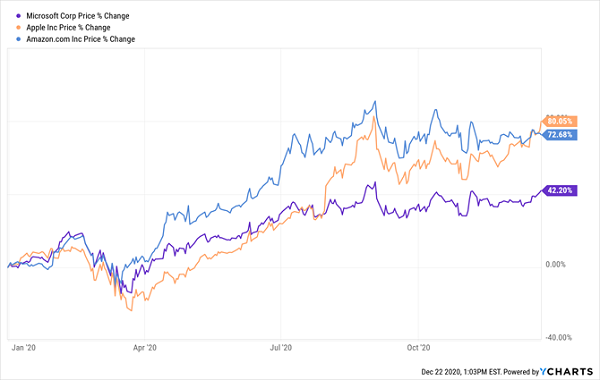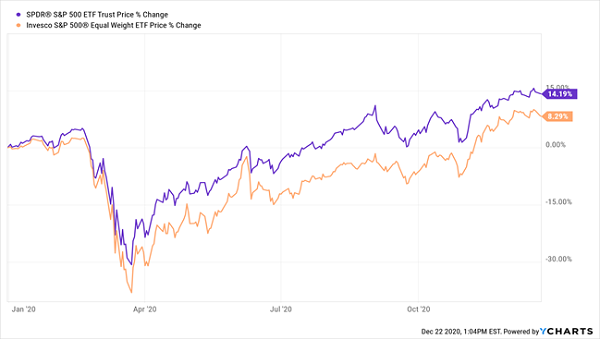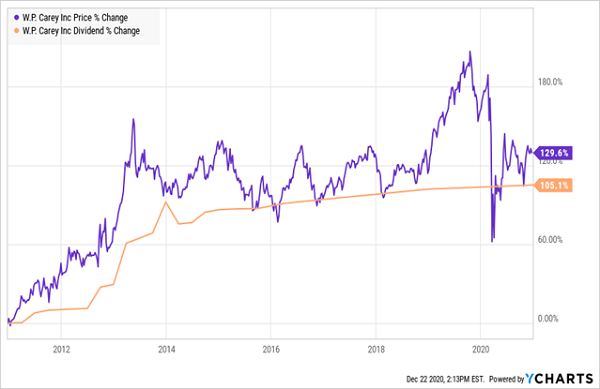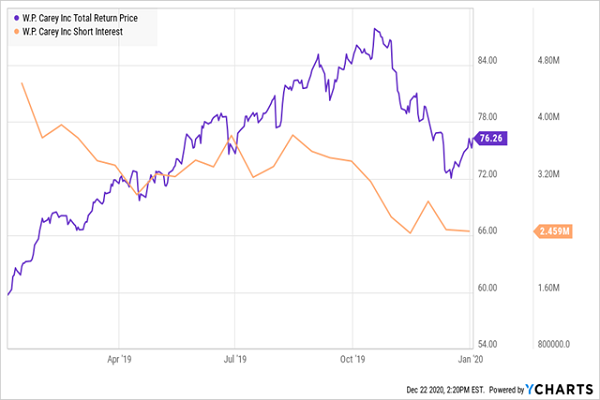If you’re making buy decisions based on the daily gyrations of the S&P 500, you’re setting yourself up for big losses—and costing yourself a shot at big dividends, too.
Why? For starters, at a 1.6% average yield, the popular names simply don’t pay enough. You’d need to save $2.5 million just to generate $40,000 in yearly dividends!
We need a better option—one that lets us save a reasonable amount of money (I’m talking $500,000 to $600,000 here) and still generate meaningful income.
I’ll give you two of my best contrarian strategies for doing that in a moment. First, let me show you why it pays to be patient right now, even though many folks are rushing to buy stocks, with the S&P 500 up 14% as I write this.
Market’s Big 2020 Gain Not Quite What It Seems
One thing everyone forgets about the S&P 500 is that the index is weighted by market cap. That gives favor to Microsoft (MSFT), Apple (AAPL) and Amazon.com (AMZN), its top three holdings, which, I’m sure I don’t have to tell you, had a banner year in 2020.
Big Tech Hogs Most of the Gains

But if you adjust for high-flying sectors like tech and look at the S&P 500 on an equal-weight basis, it’s up much less than 14% on the year:
The Real Story

That 8% return is still nice, for sure, but it’s much more in line with the market’s typical annual gain—which is why I’m advising my Contrarian Income Report members to fight the fear of missing out.
Truth is we’ve got plenty of time to deploy our capital, especially with vaccines starting to roll out and a stimulus package on the way. And with warmer weather about four months away in the northern states, the (likely permanent) end of lockdowns is on the horizon.
That makes now the time to build our shopping list and make strategic buys of stocks and closed-end funds (CEFs) with high dividend yields, big discounts and business models that set them up for growth in the recovery.
But how do we know when it’s time to move a stock from our watch list to our buy list? Let’s move on to my two favorite contrarian methods for doing just that.
Contrarian Strategy No. 1: Bet Against Short Sellers
Short selling has been around almost as long as stocks, with the first short sellers betting against the Dutch East India Company back in 1609. But unlike those pioneers of pessimism (who made a fortune, by the way), today’s short sellers are often wrong—especially at the extremes.
(If you’re unfamiliar, short selling involves selling a stock you’ve borrowed and committing to buy it back later, hopefully at a lower price. Your profit lies in the difference between the selling price and the price at which you have to buy it back.)
Before you ask, no, we’re not going to “short” stocks ourselves. Instead, we’re going to tap the short sellers’ greed for big upside and growing dividend payouts, too.
Here’s how: if a stock attracts a lot of short interest and the price moves up, the “shorts” will scramble to buy and “cover” their positions. That’s great for us because it can create a feedback loop where the rising price triggers short covering, driving the price higher, triggering more short covering, and so on.
So an unusually high level of short interest is one indicator to key in on—and it’s even more potent if you combine it with a rising dividend.
Consider W.P. Carey (WPC), my favorite industrial landlord, which has held a spot in our Contrarian Income Report portfolio on a couple of occasions. Our latest sale of the stock, before we picked it up again in early 2020, was only because WPC rewarded us with a 27.7% total return in just one year!
We had short sellers to thank for that run. When I saw short interest in the stock rising in late 2018, I took note. After all, WPC paid a generous 6.3% dividend at the time, had raised its payout for 21 straight years and had locked in its tenants with long leases—10.5 years, on average.
Management is so cash-rich they hike the payout every single quarter. Those payout hikes act like a magnet on the share price, with more investors taking note, and bidding up the share price, with each dividend hike. This “dividend magnet” has been running full tilt for a decade:
WPC’s Dividend Drives Up Its Share Price

In other words, the short selling on WPC had gotten way out of hand, so in January 2019, we pounced. Over the next 12 months, WPC reliably followed its dividend higher and the short sellers were forced to cover. Both of those events drove us to that nice 27.7% return.
We Buy In—and Profit—as Shorts Give Up

The takeaway: if you’ve found a stock with a rising payout and rising short interest, it’s definitely worth taking a closer look.
Contrarian Strategy No. 2: Watch the Right Chart for CEFs
If you read my columns before, you know I’m a big fan of CEFs, as they pay dividends that crush any payout you’ll find on the S&P 500. Right now, there are about 500 CEFs out there, yielding around 7% on average.
One thing to remember about CEFs is that, with few exceptions, they can’t issue new shares to new investors after their IPOs. That’s another way of saying their units, which trade on the open market, can trade at wildly different levels than the per-share value of their portfolios (known in CEF-land as net asset value, or NAV).
And for the record, yes, we always demand a discount!
The difference between NAV and market price is key because a CEF’s NAV is the real barometer of management’s performance, while its price bounces around based on Mr. Market’s mood on any given day. And while market prices are easy to find, NAVs are more nuanced and require a visit to Morningstar.com, YCharts.com or, best of all, the CEF’s direct website.
I’m sure you’re getting what I’m saying here: focusing on price alone can lead you to do the opposite of what you should with a CEF.
Consider another Contrarian Income Report holding, the Aberdeen Asia-Pacific Income Fund (FAX). As you can see below, FAX’s market-price return (including dividends, noted by the purple line below) fell sharply in the March 2020 selloff before bouncing back:
FAX’s Market Price Falls Sharply, Then Bounces …

A drop like that might prompt you to avoid FAX, thinking it’s too volatile.
But remember that you’re looking at the fund’s market price—and all the emotion involved with it. If you look at FAX’s NAV (the orange line in the chart below), you’ll see that its portfolio’s performance is much steadier: it didn’t fall nearly as far as the market price and was back up to breakeven on the year by July 31.
Investors took note and pushed the market price back into the green a few days later. FAX hasn’t looked back:
… But NAV Tells the True Story

That flips the script! Now we can clearly see that the March plunge was a buying opportunity—a rare shot at grabbing FAX’s portfolio of strong international bonds at an almost unheard-of discount. And thanks to FAX’s 7.6% dividend, a large portion of its return comes to you in cash.
The takeaway: if you want a true sense of CEF performance (and whether you’re really getting a deal), you need to look at the NAV—and the margin between it and the market price—to get the real story.
My Top Income Picks for 2021 Yield 8% (and Pay You Monthly)
Contrarian indicators like the ones I just showed you, along with big dividends like FAX’s healthy 7.6% payout, are the answer to surviving pandemics, economic crises—just about any calamity you can imagine.
Because when you’ve got the bulk of your return coming to you in cash, you’ve already got a huge advantage over the “buy and hope” crowd. These are the folks who stick to the popular names of the S&P 500. With virtually no dividends to fall back on, they’re forced to “buy and hope” for gains.
We won’t be throwing our lot in with this sorry bunch, especially when we’ve got my “8% Monthly Dividend Portfolio” to work with. It’s a collection of proven income plays I’ve personally selected to let you live on dividends alone.
Invest $500K in this powerful portfolio and you’ll trigger a $40,000-a-year cash stream, enough to retire on in many parts of the country. And because these stocks are monthly payers, you don’t have to wait three months for your next payout!
A steady drip of $3,300+ flows into your account every month.
Plus, thanks to their bargain valuations, you’re nicely positioned for 10% price upside, or $50,000 on a $500K nest egg, in 2021.
The time to buy these income plays is now. Go here and I’ll give you full details, including names, tickers and complete dividend histories, on the stocks and funds in this high-yielding portfolio.

Recent Comments